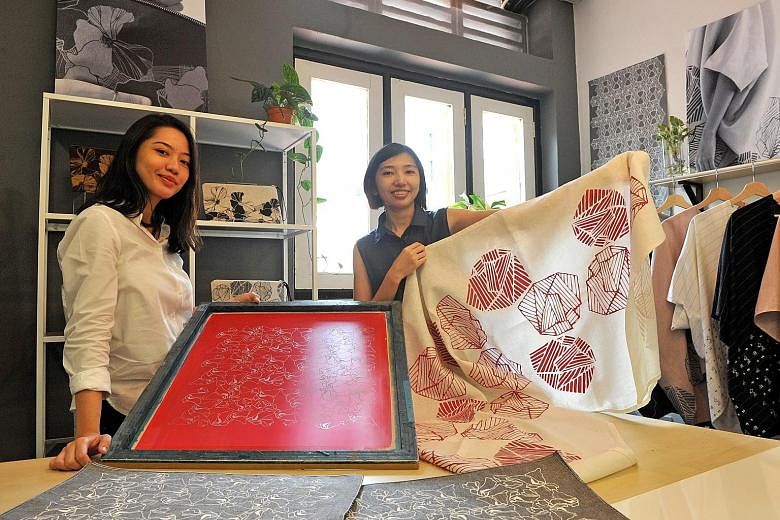Q How did you get started on your business?
Hani: Fictive Fingers is a handprinted textile design studio. The business started out as a hobby, around 2008. It was just something we did at home, mostly craft-based items, and we put them on a blog.
Aisah: When we started Fictive Fingers, the first main idea was to promote the notion that our products are handmade and made locally; to promote an appreciation for quality handmade items.
We still sell our products - pouches and kimonos - online but we are primarily a design studio, working with other brands like The Body Shop and Innisfree, and local organisations like The Substation.
Q What makes your business unique?
A There is a story behind all our prints. They are about our way of life, our personal experiences and culture. It's about authenticity and I don't think you can find the exact same story from another person.
Another difference relates to the production and creative process - the medium and colours we use. Sustainability is also something we look at, so we try to use non-toxic ink, and minimise waste.
Q How do you protect your work to stop copycats from replicating it?
A We are in the process of trade- marking our logo and our brand. For our prints, it is more about getting the copyrights and making sure we have the documentation of every print, to show we designed them. It is safer to be registered. We see intellectual property protection as an insurance for our designs.
H We started talking about protecting our work after we were featured in the newspapers and online media. They have a broad reach and you don't know who's reading the story and looking at our designs. The number of visitors to our website rose, though I would say the main push came from our customers.
Q What did your customers do?
H Some customers saw value in our work and asked if we were doing anything to protect our designs. One customer said a brand that had just come out was quite similar to what we do.
Q Were there instances where your work was copied or adapted?
H We've learnt a couple of lessons along the way. In one case, a customer really liked our products and wanted to work with us. She was leading us towards the direction of mass production, which was not something we were keen on. So we told her that was the end of the discussion. But we later found out she had gone on to create something fairly similar. A In another incident, we collaborated with a company on a packaging for their products. After three editions, we moved on with other projects. But the company re-created what we did for them on their own, and continued using the same material and colours, even though the collaboration had ended.
Q What action did you take?
A We didn't see the need for a confrontation, but took it as a lesson. So we are more careful when it comes to selecting our clients and we make sure upfront that we are very clear on what is it we will be doing together, and coming up with contracts; be more "black and white" about everything.
Sometimes with designs, it's hard to say someone's "stolen" it. It could be a parody or a different interpretation of your work. We don't worry too much about it. What we do is to keep creating, and to be honest with our community. We just move on. As a customer once told us: "Remember that ideas can be copied, but talent cannot."
Q Where do you draw inspiration for your designs?
H It could be anything, it could be a story. We follow people on social media and sometimes what they share inspires us. For example, a mother of two sharing how she spent the day with her kids.
It's about finding human connection in this technology-driven world. That's what we look out for, the little things that happen to people in their daily lives. A It's not just about making things, it's about connecting with people. So we also hold events and classes, partly to build a community of people who appreciate the quality of design and originality.
Q What are some of your expansion plans?
A Our products are associated with everyday life - a pouch you carry around, or a kimono you wear to an event - but we are now looking at how our designs can be put into living spaces. For example, bringing patterns into the home and injecting your identity into your own home.
And we want to work with more international brands. H We hope to move into this new home space some time in the middle of the year, leading up to Christmas. The idea of going into homeware or the home design industry is that there are more things we need to discover, which is both challenging and interesting.
They are much bigger items, such as curtains, sofas, or even wall murals. I think we will be mostly working with interior designers and furniture makers.


